Exploring the Architectural Marvel of Burj Khalifa Floors
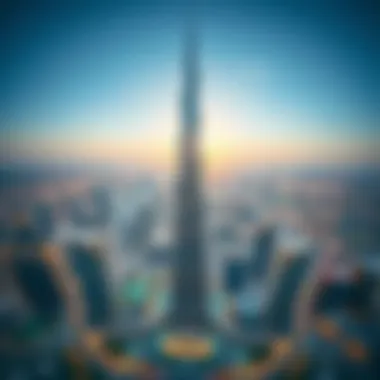
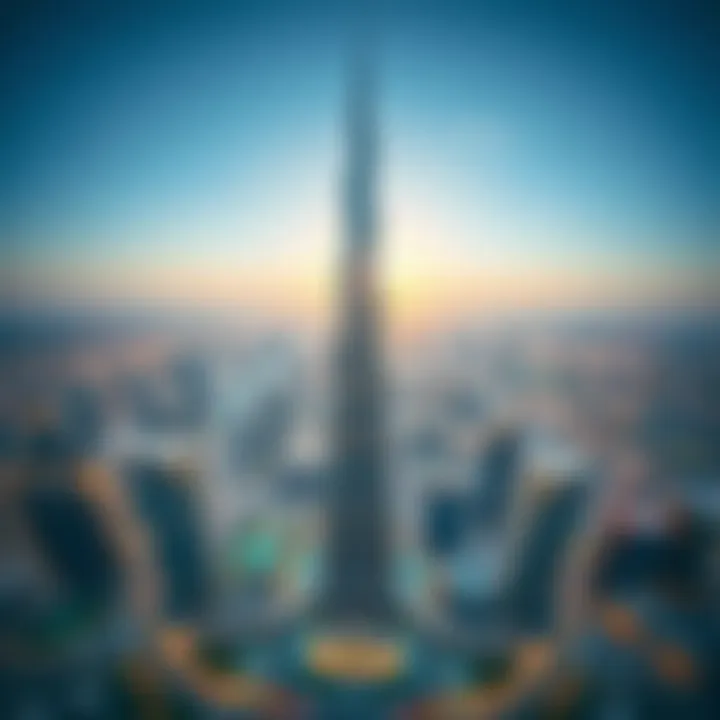
Intro
The Burj Khalifa stands as a titan on the skyline of Dubai. Beyond its breathtaking height, what encapsulates the imagination of many is its incredible number of floors and how these levels orchestrate the building's functionality. Each floor builds on the last, quite literally, creating a symphony of spaces that cater to living, working, and leisure. The architectural ingenuity involved in designing such a colossal structure is worth dissecting. This exploration intends to provide not just numbers, but also a glimpse into the lives and purposes carried within its frameworks.
At a glance, Burj Khalifa boasts a staggering 163 floors. These levels harbor a variety of differences in uses, from residential apartments on higher floors to hotels and office spaces below. This well-thought-out vertical segregation allows for a bustling microcosm within a single edifice, symbolizing the forward-thinking spirit of modern architects and engineers.
Understanding the Burj Khalifa's floors leads us down two interconnected pathways: the detailed architecture that supports this towering achievement, and the economic implications of such a structure in one of the world’s most dynamic cities. As we dissect each layer, we aim to unravel how this skyscraper not only redefined the Dubai skyline but also set benchmarks in architectural design and urban planning worldwide.
Overview of Burj Khalifa
The Burj Khalifa, setting a towering example of human ingenuity in the heart of Dubai, is more than just a tall building. It represents the confluence of ambition, architectural prowess, and modern engineering. Designed to be a destination in its own right, its various floors serve a multitude of purposes — as a statement of luxury, a hub for business, and a canvas for attracting tourists from all corners of the globe.
Historical Context
When the construction of the Burj Khalifa began in 2004, it marked the start of an ambitious project aimed at transforming Dubai into a global city and a major business hub. The building was completed in 2010, and since then, it has captured the imagination of millions. The inception of this architectural marvel stemmed from a vision that combined the cultural heritage of the United Arab Emirates with the aspirations of modernity.
Dubai's rapid growth in the early 21st century provided the backdrop for this audacious project; the Burj Khalifa was built to symbolize the rich possibilities that the city held. The structure's height — designed to reach 828 meters — exceeded any prior attempt, making it a beacon of innovation.
The Burj Khalifa stands as a testimony to the city's goal: to attract investments, encourage tourism, and showcase its forward-thinking identity. In addition, it serves as a reminder of the economic boom that Dubai experienced, turning it into a central player in the global market.
Architectural Vision
The architectural vision behind the Burj Khalifa was orchestrated by the renowned firm Adrian Smith of Skidmore, Owings & Merrill. The building is not merely about height; it's about aesthetic appeal and functionality. Inspired by the harmonious forms of nature, the design mirrors the unique calligraphic patterns that resonate with the cultural roots of the region. This intertwining of elegance and tradition is central to its allure.
The tapering structure is reminiscent of a desert flower, rising gracefully into the sky. Each of the building's key components serves a purpose, promoting both structural integrity and visual interest. The three distinct sections that comprise the building are unified in a way that balances beauty with functionality.
A notable feature of the Burj Khalifa is its observation decks, which offer panoramic views of the Emirates. Ensuring that visitors experience the height in a safe and captivating manner was part of the vision — adding to the structure's role as a landmark and a tourist attraction.
In summary, the Burj Khalifa is not just a skyscraper; it is a canvas of human achievement, a reflection of the past, and a peek into the future of urban architecture.
Understanding the Structure
Understanding the structure of the Burj Khalifa is fundamental to appreciating its architectural and engineering triumphs. This section dissects the underlying elements that contribute to its impressive stature, exploring the inspirations behind its design and the innovative techniques that brought it to life. Grasping these facets is critical, particularly for stakeholders including investors, developers, and real estate agents seeking insights into how the building not only dominates the skyline but also shapes urban living. The philosophy behind its design and the methodologies used during construction directly influence its functionality, sustainability, and the way it integrates with the surrounding environment.
Design Inspiration
Natural Formations
Burj Khalifa draws significant inspiration from natural formations, particularly the desert flower, Hymenocallis. This flower's structure is not only visually striking but also efficient in its design. The natural formation element serves as a reminder of organic beauty, presenting an architectural aesthetic that resonates with the local environment. Key characteristics include a flared base that narrows upwards, reflecting how many natural structures grow—broad at the foundation.
This choice benefits the building by allowing for a remarkable height while maintaining stability. The distinctive shape also aids in wind resistance, critical for a structure soaring over 828 meters. The organic design helps Burj Khalifa stand as a testament to nature’s efficiency, merging art with engineering.
While this approach certainly enriches the visual appeal, it also poses challenges. For instance, achieving the desired form without compromising structural integrity required rigorous analysis and advanced modeling.
Cultural Influences
Delving into cultural influences, the Burj Khalifa integrates significant elements from Islamic architecture. The tiered design, reminiscent of a minaret, reflects the cultural context of its location. This aspect serves to create a sense of place, honoring the heritage of Dubai while showcasing forward-thinking architecture.
The use of geometric patterns, prevalent in Islamic design, adds another layer of significance. These patterns are not merely aesthetic; they connect the past to the present, symbolizing continuity and innovation within the same structure. The choice of cultural influence resonates well with the audience, particularly those interested in the blend of tradition and modernity.
However, using culturally inspired designs can be a double-edged sword, as it may open doors to debates regarding authenticity versus representation in architecture. Despite any criticisms, it ultimately enriches the narrative of Burj Khalifa.
Construction Techniques
Materials Used
The materials utilized in constructing the Burj Khalifa showcase not only advanced technology but also thoughtful selection for durability and aesthetic appeal. High-performance concrete was the backbone of the structure, providing lasting strength required to support immense weight. Furthermore, these materials contribute to energy efficiency, ensuring the building stays cool in the sweltering Dubai heat.
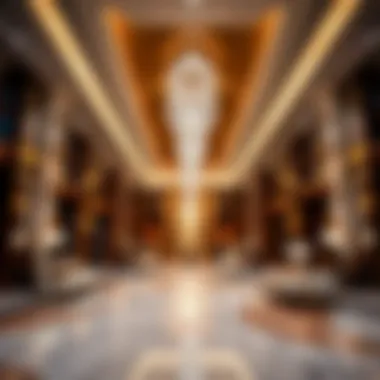
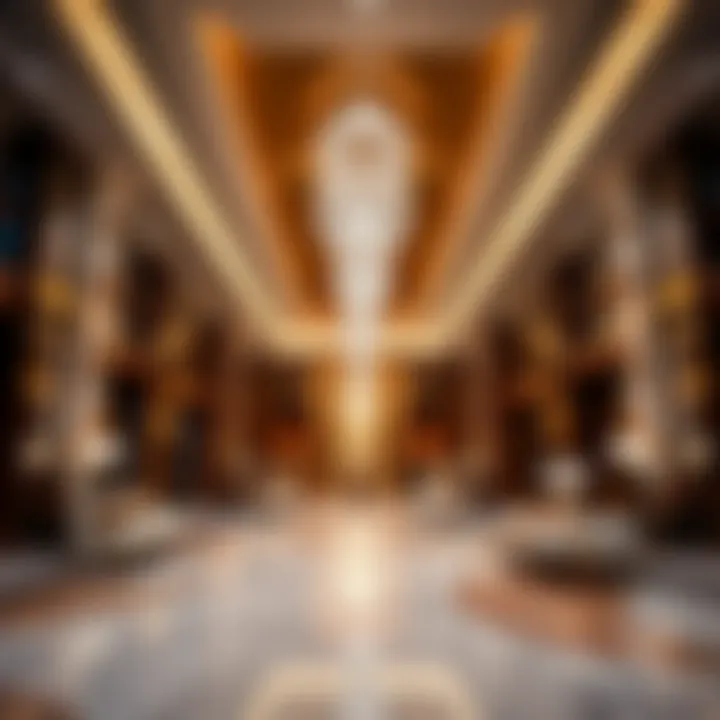
The unique feature of this concrete mix is its ability to withstand the pressure of height, preserving structural integrity while minimizing weight. Utilizing such innovative materials highlights a commitment to sustainability, reducing energy loads while meeting the challenges presented by its imposing height.
However, sourcing such specialized materials posed challenges, as few suppliers met the rigorous standards needed. The difficulties in and logistics of material acquisition were significant, yet these hurdles were successfully overcome through strategic planning and partnerships.
Innovative Engineering
When examining innovative engineering, Burj Khalifa showcases cutting-edge solutions to meet the demands of its towering height. A unique feature is the use of a bundled tube design, which provides exceptional stability and requires less core support. This approach not only maximizes usable space but also enhances resistance to lateral forces, such as those posed by strong winds.
Additionally, the tower’s lifts are designed to move faster than conventional elevators, keeping pace with the needs of its occupants. This characteristic is particularly beneficial in a high-rise where waiting times can negatively affect efficiency.
Nevertheless, pushing the envelope with engineering also involves risks. The complexities of integrating advanced technologies into design and function necessitated a high level of precision and testing, underscoring the commitment of the engineering teams involved in the project.
"Burj Khalifa exemplifies where innovative engineering meets architectural beauty, embodying both the aspirations of a city and the realities of modern construction."
Through the understanding of such intricate structure elements, one can appreciate not just the extents of human creativity but also the broader implications of these advancements in urban planning and architecture.
A Closer Look at the Floors
The Burj Khalifa, an architectural wonder, boasts a remarkable floor count that plays a crucial role in its overall design and functionality. This section aims to unravel the intricacies associated with the total number of floors and how they serve the building’s broad purpose. By examining the floors more closely, we can appreciate how each level contributes to what makes this skyscraper stand tall not just in physical stature but also in significance.
Total Floor Count
Standing at a striking 828 meters, the Burj Khalifa is home to a staggering 163 floors. This total isn't just an arbitrary number; each level is strategically designed and utilized, making the tower a microcosm of urban life. The sheer height and extensive floor count symbolize the ambition of human achievement and modern engineering.
Function Distribution
The functionality of the Burj Khalifa does not simply stop at the number of floors. Instead, the distribution of its functions across these floors illustrates deliberate architectural planning, maximizing the use of vertical space. Each section within the building serves a distinct purpose, which enhances livability, work, and leisure.
Residential Areas
On the higher levels of the Burj Khalifa lie the residential areas, containing luxurious apartments that reflect both opulence and a blend of comfort. Each residence is designed with panoramic views of the skyline, potentially making them a sought-after choice for wealthy individuals. The key characteristic of these residential spaces is their exclusivity and modern elegance, attracting home buyers who yearn for a lifestyle that epitomizes luxury. However, the high cost of living in such an iconic building may deter some potential residents.
The unique feature of these residential floors is the curated amenities that accompany them, such as rooftop gardens, fitness centers, and leisure lounges. These facilities not only cater to the residents' needs but also foster a sense of community within the vertical dwelling. Nevertheless, one can argue that the elevated costs associated with living here may be a disadvantage for average buyers.
Commercial Spaces
Perched in the lower to mid-levels of the structure are the commercial spaces, which house a range of businesses from offices to fine dining. The strategic placement of these business areas makes the Burj Khalifa a bustling hub, as both residents and tourists flock to the vicinity for work and leisure. The commercial spaces stand out due to their cutting-edge design and high-tech facilities, making them a lucrative choice for businesses.
A notable advantage of these floors is the ability to network in a dynamic environment; however, this high-profile location comes with premium leasing costs that can be a barrier to entry for small startups. The presence of large corporations can intimidate smaller businesses and push them out, which could lead to a homogenized experience.
Observatory Deck
At the pinnacle of the building sits the observatory deck, an iconic space allowing visitors breathtaking views of the surrounding landscape. This observation area is vital for tourists and locals alike, offering an unparalleled perspective of Dubai’s skyline and attracting thousands each year. The charm of the observatory lies in its sheer height and the exclusive experience it provides.
What makes the observatory deck remarkable is its state-of-the-art design, featuring large viewing windows and interactive displays about the city’s history and culture. Yet, while entertaining, maintaining safety protocols and managing large crowds can be a challenge, leading to sometimes lengthy waiting periods, which might deter potential visitors.
In summary, the floors of the Burj Khalifa are far more than mere levels; they are thoughtfully crafted spaces that contribute significantly to the building’s identity. From luxury living to bustling business environments and panoramic vistas, every floor plays an integral role in the overall experience of this spectacular architectural feat.
Key Amenities and Highlights by Floor
The Burj Khalifa is not just a towering marvel; it is a carefully orchestrated blend of various amenities spread out across its many levels. These offerings significantly enrich the experience for residents, visitors, and businesses alike. Understanding the key amenities within this iconic structure helps highlight the diverse functionalities that make the Burj Khalifa a landmark in urban architecture.
Ground to Level
Lobby and Reception
The lobby and reception area serves as the welcoming heart of the Burj Khalifa. This vast space is designed to impress upon arrival, featuring high ceilings, tranquil water features, and striking artwork that captures the essence of Dubai’s cultural milieu. It is often the first contact point for tourists and residents, making its ambiance crucial for setting the tone of their experience.
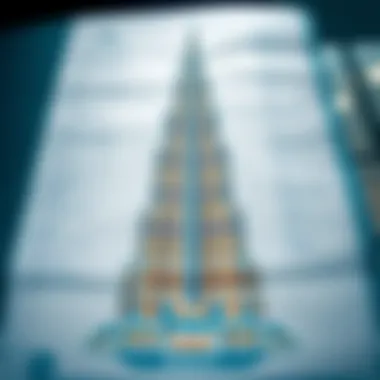
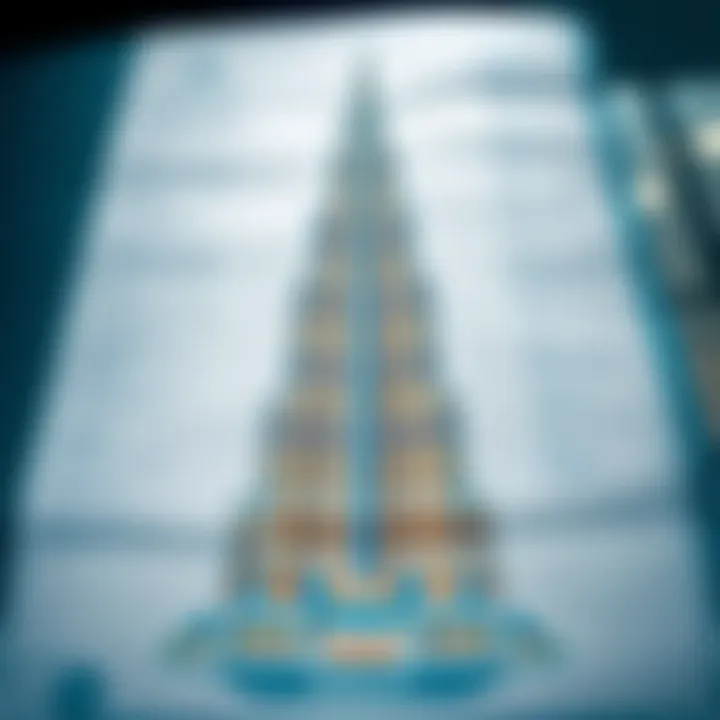
A key characteristic of this lobby is the utilization of natural light, accentuated through expansive glass windows, allowing a seamless transition between the interior and the breathtaking views of the city. This choice is beneficial not just from an aesthetic point of view, but it also showcases energy efficiency, which is a growing concern in modern architecture. One unique aspect of this lobby is its direct links to other floors through high-speed elevators, ensuring quick access for both visitors and residents—an essential convenience in such a sprawling structure.
Dining Facilities
The dining facilities within the Burj Khalifa offer an eclectic range of culinary experiences, catering to a variety of tastes and preferences. High-end restaurants operate here, featuring menus designed by top-tier chefs, which makes it a popular choice for both casual diners and those looking to celebrate special occasions. This range elevates the building’s status as a gastronomic hub, appealing significantly to tourists looking to indulge.
Noteworthy is the stunning view from many dining spots, particularly those located near the observation decks. The panoramic views of the city are a highlight, providing diners with an unparalleled backdrop during their meals. However, it is important to acknowledge the upscale pricing associated with these facilities, which can deter some potential visitors. A unique feature of these dining options is the seasonal menus that incorporate local ingredients, allowing an authentic taste of Emirati cuisine that truly resonates with the culture.
Mid-level Amenities
Office Spaces
The mid-levels of the Burj Khalifa are designated primarily for office spaces, offering an environment that combines luxury with functionality. These offices are designed to meet the needs of a diverse array of businesses—ranging from startups to established multinational corporations looking for a prestigious address. A key characteristic of these offices is their flexible design; many spaces can be adapted to suit varying requirements, enhancing their usability.
The significant heights and vistas from these mid-level offices create an appealing workplace atmosphere. Employees can work amidst breathtaking views of the cityscape, leading to potential increases in productivity and morale among staff. However, this convenience comes with costs that may be higher than the average office space in Dubai, establishing a barrier for some smaller businesses. A standout element here is the integration of cutting-edge technology in the office spaces, supporting a modern way of working that includes collaborative areas and private meeting rooms.
Business Centers
The business centers located within the Burj Khalifa reflect a commitment to convenience and sophisticated service. Here, a blend of modern facilities and professional environment fosters productivity. These centers often come equipped with high-tech conference rooms and reception services, making them an attractive option for companies looking to impress clients.
The centralized location offers significant advantages for networking opportunities, as many of Dubai’s major business hubs are nearby. A unique feature of these business centers is the accessibility to shared locations where professionals from various industries can interact, encouraging collaboration. However, room for improvement exists in terms of available space during peak hours, which may limit usability for all tenants. A distinguishing factor is the presence of premium features such as video conferencing technology, which has become increasingly relevant in this digital age.
Upper Levels
Luxury Apartments
The upper levels of the Burj Khalifa house opulent luxury apartments, synonymous with high living standards. Each living unit boasts breathtaking views, high-end finishes, and exclusive access to various amenities such as infinity pools and personal concierge services. A definitive characteristic of these apartments is the meticulous attention to design that emphasizes both aesthetics and functionality.
Potential residents are drawn to the unique lifestyle that the apartments offer, with direct access to hotels and restaurants within the same building. A distinctive feature is the smart home technology incorporated into each unit, allowing for an enhanced living experience through automation. However, the sky-high prices may not be achievable for everyone, which can create a perception of exclusivity. The layout of these apartments encourages a blend of privacy and social interaction, fostering a community feel amidst the heights of luxury living.
Sky Lounge
The Sky Lounge, perched at an impressive elevation, is a prime highlight among the upper level amenities. It offers a sophisticated social space that combines luxury with leisure, making it a popular destination for both residents and guests. The key characteristic of the Sky Lounge is its stunning panoramic views of the horizon and the Dubai skyline, which compel visitors to linger and savor the experience.
The open design fosters an atmosphere of relaxation and interaction, appealing especially to those looking to unwind or entertain guests. A unique aspect of this lounge is its curated selection of beverages and light bites that capture the essence of global tastes. Nevertheless, accessibility can be a concern during peak times, with the area sometimes overcrowded. The design elements, with floor-to-ceiling windows, provide an unobstructed view, enhancing the overall experience for anyone looking to enjoy a moment high above the bustling city.
In summary, the Burj Khalifa stands out as a beacon of architectural and functional excellence. Each floor serves not just as a space but as an experience in itself, making the structure a testament to modern innovation and the vibrancy of Dubai. It is an engaging blend of luxury, practicality, and artistic vision that thoroughly enhances the fabric of urban life.
Economic Impact of Burj Khalifa
The Burj Khalifa is more than just a stunning skyscraper; it’s a powerful catalyst for economic development in Dubai and beyond. By examining the economic implications of this towering marvel, we can appreciate how it has transformed not just the skyline but also the local economy and the real estate landscape. The significance lies in its ability to attract tourism, drive investments, and influence market trends, making it a central player in Dubai's economic narrative.
Tourism Growth
The Burj Khalifa is a key attraction for tourists worldwide. As the tallest building globally, it draws millions who wish to witness its grandeur and catch a view from the observation deck. The influx of visitors does not merely impact ticket sales; it stimulates local businesses—from hotels and restaurants to retail outlets and tour services.
For example, the success of the Burj Khalifa has influenced the establishment of luxury hotels nearby, catering to tourists who want to enjoy proximity to this landmark. The Dubai Mall, located at the base of the building, sees a significant number of visitors who come for shopping, dining, and entertainment, often planning their trips specifically around visiting the Khalifa.
A recent study noted that tourism in Dubai increased by over 10% annually since the Burj's completion. The city's branding as a tourist hub has benefitted tremendously, supporting thousands of jobs and several sectors reliant on tourism. As more visitors come to witness a masterpiece, the economic benefits ripple through various facets of the economy.
Real Estate Market Influence
The presence of the Burj Khalifa has undeniably transformed Dubai’s real estate landscape. Its very existence elevates property values in the area. The allure of living or working within sight of such an iconic edifice draws affluent buyers and investors.
Key influences include:
- Increased Property Values: Surrounding developments have experienced heightened demand, leading to rising prices in both residential and commercial sectors. Properties that can boast a view of the Khalifa often command premium prices, enhancing their marketability.
- Luxury Developments: There has been a notable shift towards luxury real estate, with developers launching high-end residential projects near the Burj. Buyers seek not just homes, but an experience linked to the prestige associated with living close to this architectural wonder.
- Commercial Growth: The business environment flourishes, with office spaces in proximity to the Khalifa becoming highly sought after by companies aiming to project an upscale image.
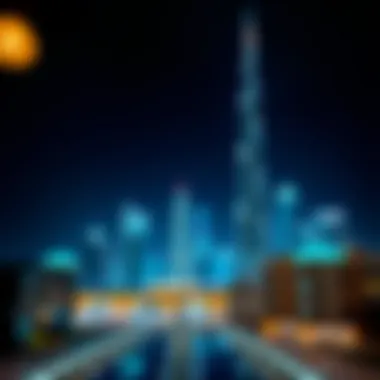
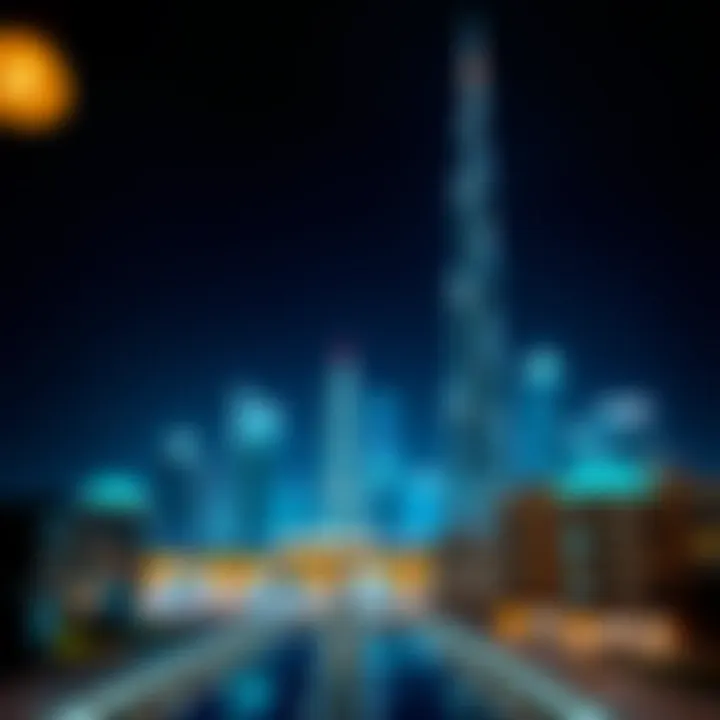
The ripple effect continues to evolve; as top developers market their projects in Dubai, the Burj Khalifa stands tall as evidence of opportunity and growth. Investors eye the area, knowing that a property here could yield substantial returns in the future.
The Burj Khalifa is a potent symbol of what's possible, a testament to innovative thinking and necessary investment in urban environments.
Challenges Faced During Construction
Constructing the Burj Khalifa was not merely a matter of executing an architectural vision; it involved overcoming a series of formidable challenges that tested the limits of engineering and construction methods. Understanding these obstacles is crucial to appreciating how the Burj Khalifa emerged as a beacon of human ingenuity. The project encountered problems related to technical specifications, logistical arrangements, and environmental factors, all of which were critical in shaping the final outcome of this monumental skyscraper.
Technical Difficulties
One of the foremost hurdles during the Burj Khalifa’s construction was managing its complex design and structural requirements. The skyscraper's unique shape, inspired by the hymenocallis flower, required rigorous calculations to ensure stability and safety. The concrete mix had to be specially developed to withstand the immense pressure exerted on lower levels due to the building's height. Conventional concrete could not suffice; instead, a high-strength concrete blend was adopted, which performed exceptionally under high-stress conditions.
Aside from the concrete, the significant height necessitated innovative pumping techniques. Standard pumps couldn’t reach the upper levels, so the construction team employed a high-pressure pump specifically designed for this task, pushing concrete to a height of over 600 meters. This required not just cutting-edge technology but also meticulous planning and coordination among multiple teams working at different elevations.
"The Burj Khalifa wasn’t just built; it was engineered with an unparalleled understanding of material science and structural dynamics."
In addition to the concrete challenges, the construction methods needed to evolve continually. Each change in design or unforeseen complication during construction demanded re-evaluation, adaptability, and frequent consultations with engineers and architects alike.
Weather Conditions
Weather posed another formidable challenge throughout the construction process. The extreme temperatures in Dubai, which can soar over 40 degrees Celsius in the summer, placed additional strain on both personnel and materials. Construction workers had to contend with heat exhaustion, which led to a complicated scheduling process, limiting work hours during peak temperatures. This added to project complexity, as time was of the essence to meet the ambitious timeline for the building's completion.
Moreover, dust storms prevalent in the region hampered visibility and made outdoor work particularly hazardous. Machinery would often require extensive cleaning after storms, slowing progress. During construction, dust accumulation could have detrimental effects on the quality of finishing work. Therefore, teams needed to adopt preventive measures, like utilizing specialized covers and planning exterior work around weather forecasts.
Future of Burj Khalifa
The Burj Khalifa is not just a piece of architecture; it’s a living, breathing symbol of human ambition and innovation. As we look to the future of this iconic skyscraper, it becomes crucial to consider how its structure and functionality will evolve to meet the changing needs of society and the environment. Architectural marvels need to adapt, and the Burj Khalifa is no exception. Sustainability initiatives and technological advancements are pivotal elements that will define its future.
Sustainability Initiatives
In an era where climate change is at the forefront of global discussions, the sustainability initiatives surrounding the Burj Khalifa play a vital role in its ongoing relevance and functionality. To maintain its status as a leading landmark, the building is actively pursuing several eco-friendly measures. Some of these initiatives include:
- Water Management Systems: The Burj Khalifa employs state-of-the-art water recycling processes. The building collects and treats waste water, which is then reused for landscaping and irrigation. This not only conserves precious water resources but also enhances the greenery around the building, creating a more appealing environment.
- Energy Efficiency: With initiatives aimed at reducing energy consumption, energy-efficient lighting and HVAC systems are employed throughout the structure. The use of smart building technologies allows for the monitoring and managing of energy use, leading to significant reductions in the overall consumption.
- Sustainable Materials: Future renovations and constructions within the tower will prioritize sustainable materials. This means selecting products that have a lower environmental impact and a longer lifespan, ensuring that the Burj Khalifa can stand tall for generations without compromising ecological integrity.
Incorporating these sustainability initiatives not only enhances the building’s performance but also solidifies its reputation as a leader in environmentally responsible design.
Technological Advancements
The Burj Khalifa has always been a beacon of innovation, and as it marches forward into the future, embracing new technologies will be critical. Here are some promising technological advancements that could shape the future of this skyscraper:
- Smart Technologies Integration: The future may see further integration of smart technologies, allowing for advanced monitoring of building systems to optimize performance. This involves using sensors that can detect energy use patterns, occupancy levels, and even environmental conditions, providing real-time data for management.
- Augmented Reality for Visitors: Imagine using augmented reality to enhance the visitor experience. Tourists could interact with the skyscraper in new ways, learning about its history and architecture through digital overlays that bring the past to life while providing engaging narratives about its design.
- Drones for Maintenance: The employing of drones presents a new frontier for maintenance and inspections. Drones can conduct regular assessments of the structure and identify potential issues early on, significantly reducing downtime and increasing safety for maintenance crews.
- Enhanced Security Systems: As urban environments evolve, so do security threats. Future advancements may include cutting-edge surveillance technologies and AI-powered systems that enhance safety protocols without diminishing the visitor experience.
Each of these advancements not only enhances the structural integrity and utility of the Burj Khalifa but also reinforces its position as a pioneer in the realm of skyscrapers.
"The Burj Khalifa, with its eyes turned towards the future, continues to inspire innovation while being a monument to sustainability and technology."
Epilogue
The Burj Khalifa stands not just as a towering edifice dominating the Dubai skyline, but as a milestone in architectural ingenuity and design. A myriad of aspects converge within its floors, each telling a story of human ambition, meticulous planning, and groundbreaking engineering. Understanding the significance of the Burj Khalifa in this article sheds light on its legacy and the impact it leaves on future constructions.
Legacy of Burj Khalifa
One cannot overlook the monumental footprint Burj Khalifa has left in architectural history. It is more than just the tallest building; it redefines what skyscrapers can be. Spanning a staggering height, its floors accommodate a diverse array of functions, from luxurious residential units to bustling commercial spaces. This multifunctional approach showcases a profound understanding of urban needs.
Moreover, the Burj Khalifa's design is closely tied to cultural elements from the UAE, reflecting both local tradition and modernity. The craftsmanship, from its exterior cladding to intricate interiors, has set a benchmark in the construction industry. Aspirationally, it tempts future architects to push beyond conventional boundaries.
This architectural marvel has also fueled economic growth by boosting tourism and real estate investments, reaffirming the belief that well-thought-out urban design can yield significant financial returns. Notably, the Burj Khalifa continues to commit to sustainability, standing as an example for new projects worldwide.
Impact on Future Structures
The impact of Burj Khalifa stretches far beyond its sheer height. It encourages a reevaluation of urban planning policies and construction techniques. Architects and developers echo its form and function while striving to create structures that promote sustainability and multi-use spaces. Its design complexities have inspired a new wave of innovation, judging by emerging concepts worldwide.
Burj Khalifa advocates for thoughtful integration of technology in architecture. What started as a vision is now a model for smart buildings and eco-friendly advancements, which many future buildings now aim to emulate. The dual narrative of luxury and performance embedded in its DNA encourages others to visualize possibilities previously deemed unattainable.











